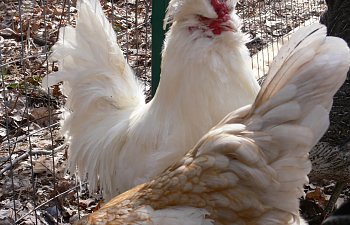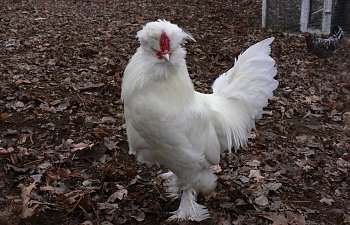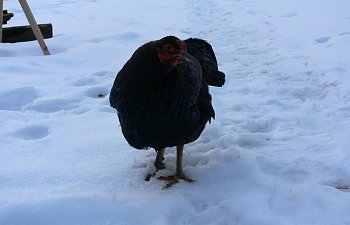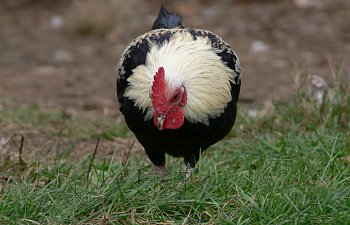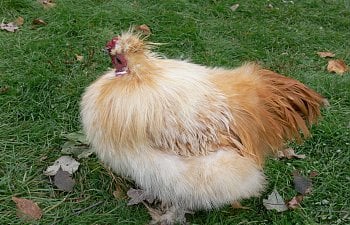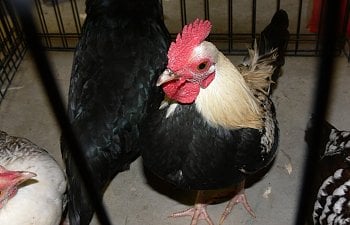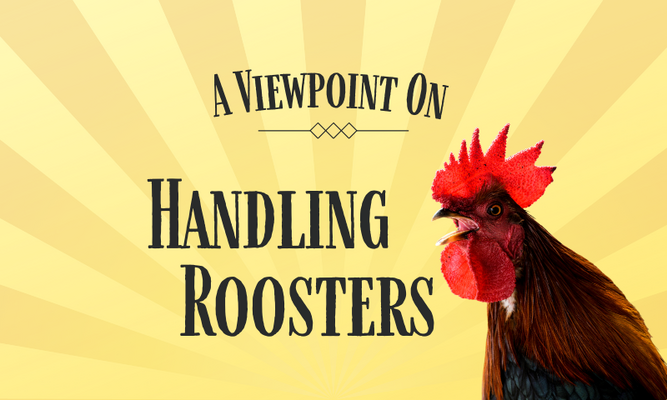Why Roosters? Where Should I Start?
Roosters are a vital part of a well-rounded flock. They provide a watchful eye against predators, genes for the next generation, and keep social stability in a group. It is my opinion that a flock without a rooster is missing out on a good deal of their natural dynamics and social behaviors. However, they can become aggressive towards humans, which may be anything from annoying to dangerous. There is occasionally intense discussion over what causes aggression, whether it can be prevented, and what to do about it. This article is an account of my own experiences with roosters over the last ten years, which continue to grow and change as I notice new things about my birds. My goal is not to barge in and change your flock management, but rather to open a discussion around aggression and body language. The best source of information about roosters is, well, a rooster. There is no substitute for spending time with your flock.
Before adjusting my management practices, I assess the flock as a whole. What is their living space like? How many birds are there? My flock is typically somewhere from 30 to 70 birds, consisting of ornamental, layer, and dual-purpose type chickens, along with ducks, quail, and guinea fowl. Most of them live in a 12’ x 12’ walk-in coop with an attached, netted run around 15’ x 20’. During the summer, they free-range in a wooded area with plenty of brush and other cover. In my experience, birds with a lot of space and more companions, i.e. more experienced socially, tend to be less inclined to human aggression. This is just an example of a difference you may find between my flock and yours, and it does not speak to every flock. I estimate that I have had somewhere around 350 birds in total, and I further estimate that around 50 of them were roosters that reached at least a year old. Out of these, I have had 3-5 birds with chronic aggressive behaviors. I consider all but one of them to be due to my ignorance, and perhaps even the last one was as well.
Questions to ask yourself: How much space do my birds have? Do they have opportunities to forage? How many birds are there and what is the male/female ratio? Is my flock multi-generational or all the same age? Is my coop a walk-in or sized for chickens only? Do they free-range or live in a run?
What Causes Aggression?
Although multiple things contribute to aggression, such as genetics, flock dynamics, environment, and personality, the body language between caretaker and bird seems to be the most important factor. Unfortunately, some people are not aware of what their body language is saying, and because of this, they believe it’s not important. Birds, or more accurately, animals in general, rely on body language and a limited set of vocalizations to survive, reproduce, and maintain a group. Body language isn’t limited to communication within a species, though many of the details are lost with increasing differences. Clever Hans, a horse that lived in Germany, is a famous example of this. By picking up on subtle facial movements, he was able to seemingly add numbers and answer questions. However, beyond the unusual outcomes of cases like Clever Hans, aggressive intent is perhaps the easiest to communicate across species. I know many chicken keepers in my local area, and through watching them interact with their flocks, I have noticed that every person with multiple aggressive roosters has a way of walking up to and interacting with their flock that makes me uncomfortable on behalf of the birds.
Genetic traits partially determine the rooster's sensitivity to body language. I'm sure you have heard the saying "Genetics load the gun, but the environment pulls the trigger." This is just as true with chickens, and my management style may differ between genetic groups. Flighty, sensitive birds, such as many from the Mediterranean class, often benefit from a gentler, consistent hand. Slower, stubborn birds might need a little more force to respond, but in general, do well with a wide variety of management styles. Beyond breed differences, I notice the most variation between birds bred carefully from a specific line. Breeding for temperament does seem to work, but among unselected hatchery lines, I notice little difference. Speaking in broad strokes, I find that large dual-purpose breeds are the gentlest. Game bantams tend to have more spirit, but are smart enough to work with you in a way that some birds aren't, and I rarely have issues with them. That said, my meanest rooster was a breed I would typically consider to be docile.
Questions to ask yourself: What breeds do I raise? Do I notice that all my roosters are aggressive or is it just one bird? Does my rooster seem more reactive when I do certain things?
Raising Cockerels
My goal is to prevent aggression, rather than retrain it. It is much harder to work with a rooster once they have made it a habit. Preventing aggression starts before I even put the eggs in the incubator. I think chickens need far more space than the bare minimum often thrown around of 4 square feet indoors plus 10 square feet outdoors. I like to have 8 square feet per bird in the coop, and double or more in the run. I provide a variety of logs, sticks, leaf piles, and occasionally a few hay bales, which have proven to be a chicken favorite. A bored chicken is going to develop maladaptive behaviors. In the coop, I ensure there are many different roost levels and places where lower-ranking birds can hide safely. Once these fundamentals are laid, I also prefer a multi-generational flock. Birds kept alone or with same-age peers have stunted social skills, which carries over to how they see humans. When older birds teach younger birds how to behave, they learn how to respond to pressure from body language and are easy to work with. If you are starting a flock, I recommend buying only female chicks, waiting a year, and then adding a new batch of chicks with a cockerel in the mix. The mature hens will teach the cockerel much of what another rooster would. In my flock, the senior roosters do all the work and I merely use the same cues to communicate with the new cockerel.
Starting on day one, I treat all of my chicks the same, male or female. They spend the first few weeks of their life in an indoor brooder under a heating pad. I pick a few of them up whenever I change their feed or water, but I don't handle them constantly. Living indoors helps to desensitize them to humans in a variety of postures at many different levels. Once the young birds are around a month, they become more skittish and resistant to handling, likely from having so many pin feathers. I let them come back around in their own time. The cockerels should be identifiable at this age. Often they are friendlier than pullets and more interested in socializing with humans. I don't necessarily discourage this immediately, but there are a few signs as they get older that will make me move them out of my space. The first of these is a vocalization I have put below in a short video. It's often paired with something I refer to as a "pivotal display, " when a bird holds their body stiffly and tends to display their sides, moving as though on a pivot point in the center, typically keeping its awareness trained on you. I wouldn't mark this as aggressive, but rather as a sign that they are feeling their oats and need to respect your space.
It's important to note that every change I make in my behavior is reactive, not proactive. If I have a cockerel that's docile, comfortable turning his back on me, and doesn't show any of these signs I am not going to worry about changing things. If I have a two-week-old cockerel sparring with my fingers, exhibiting pivotal display behaviors, and deepening his vocalizations, I keep him away even in the brooder.
As the cockerel reaches 3-5 months old, I start encouraging independence by not picking him up as often and starting to change my body language towards him. I do not move out of his way, I ask him to move out of mine. I keep my shoulders square but relaxed, feet square, and I move through him (not at him) when he's in the way. I don't chase him, he's done nothing wrong, I simply ask for respect with my stance. My goal isn't to provoke him, which some people accidentally do by adding intense eye contact and being very aware of where he is at all times. A shorter or hunched posture with hands reaching towards the bird is also threatening in a predatory way. I don't make these changes suddenly, in fact, gradually is best so as not to startle the rooster. I have a personal space of a 1-2 foot radius around me and I keep him out of it. If he walks inside my personal space and seems to be paying too much attention to me, I push him with my foot to ask him to move out of this personal space bubble. I am not advocating punting a cockerel halfway across the yard. I use a small push to move him out of my space, which I could do with the same intensity by bending over and giving him a tap with my hand. I have not found that it causes an aggressive response, rather, I think using my foot makes it easier to keep my upper body language clear and fairly neutral. I drop this behavior immediately and ignore him after he moves a few feet away. When watching my birds from a distance, I almost always see that this method is how a dominant bird corrects a younger bird that is not a threat. Pecks or postures are dropped as soon as the younger bird moves away, and the older bird seems to forget about the incident immediately. In serious fights where the winning bird continues to chase the loser, he is then terrified and will beat himself against the coop walls trying to get away. I think this is abusive when done by a human, and to maintain would require you to live in the coop and take over the role of leading rooster entirely. I don't advocate peace by fear when working with any animal. Chickens are no exception. My goal is to use cues taken from normal chicken communication, not to become a rooster and fit into the pecking order.
To provide some more evidence for my thoughts, I let a cockerel grow up without asking him for space at all. If he was in my way, I moved around him. I let him eat out of my hands, sit on my head, and didn't correct any aggressive behaviors. By about 7 months old he was sparring with my hand and pecking aggressively. It is also possible to raise friendly roosters, as I cover later, but I always start with the same basics and then let them back into my space later, after they have settled down.
Questions to ask yourself: Is my coop setup appropriate? What age ranges does my flock have? Does my rooster seem afraid of me? Will he move out of my space casually, run away quickly, or not move at all?
Retraining Aggressive Roosters
If it is safe, I recommend giving an aggressive rooster a chance. If children are involved or the rooster is particularly bad, I prioritize human safety and would put the bird on the next cull list. It helps to understand the reasons why the rooster may be attacking. There are at least two broad categories within the label of "human aggressive." The first is fear-based aggression, which is characterized by the bird holding its feathers close to its body and head high, moving in jerks, and making alarm calls when their keeper walks into the yard. When they attack, it is usually from behind, and they may run away when confronted. Scared birds will bite as well if handled. Familiarity-based aggression is more common in former lap pets and birds raised with a lot of human contact. They are very interested in people and have no fear of getting close. However, they are set off easily by small hand or body movements that they don't like, or seemingly for no reason at all. Biting seems less common but does occur particularly if you reach under him with an open hand. Quite often a bird will show a mix of both and needs an individualized plan.
When dealing with fear-based aggression, it often stems from inconsistent handling in the past or perhaps just being new to your flock. I find that most new adult roosters are aggressive at first, but quiet down quickly with proper handling. First, I spend some time holding the rooster. When I go to do chores, I'll catch him with as little fuss as possible and carry him around, not reacting to pecking or squirming. Eventually, he'll realize he's not going to die and calm down a bit. I like to pet them a bit, touching their face gently and waiting until they calm down with that too. After a few weeks of this, he may still not like you much but the edge of fear wears away. When working with him on the ground, I move rather slowly and consistently in a predictable way. I don't move around him but I might slow down and pause for a second to allow him to move away without panicking. Once he gains confidence, I have found that this is no longer needed and I can slowly move towards treating him like any other rooster. The most important part here is consistency. If a rooster can't predict what I am going to do next, he is very often frightened and sees me as a threat.
With familiarity-based aggression, I keep the rooster out of my space in a stricter fashion. I don't let him closer than a few feet even if it seems accidental. If he perches above head level on objects and stares down at me, I pull him down and move him away. I am careful to be consistent with this. I will only scare him if I am friendly one day and hostile the next. I don't jump on him suddenly; my intentions are never concealed. He does not need a five-minute warning, but if I stayed disengaged up until I turned and jumped at him, he would eventually shift into fear-based aggression. When an attack happens, I move towards him and keep pushing him backward with my boot until he gives up and runs off a few feet, starting with low intensity and going up slightly if needed. Do not kick or hurt your bird. This is unnecessary. When he has given up, I keep looking at him and turn to the side slightly, remaining engaged but not encouraging another attack with aggressive moves. If I let off immediately, as mentioned in the "Raising Cockerels" section, it tells him I'm not serious and opens me up for another attack. Usually, my roosters walk off at a slower pace and disengage first when they don't want to attack again. Sometimes it takes a few cycles, and if he seems persistent, check your body language to see if he may be provoked by something you're doing. Once he walks off a few steps, I disengage too and return to my normal chores.
I use the same approaches explained above with a bird that I think might become aggressive later. I have noted several warning signs that seem to reliably predict future aggression without proper intervention. Some of these only apply to one type of aggression, and others apply to both. Overall, fear-aggressive roosters act more like I am a predator, and familiarity-aggressive roosters act like I am a hen or a member of their flock rankings. The greatest commonality to all these signs is that they involve attention. I don't want my roosters to place much more attention on me than any other feature of their surroundings. Ideally, even when I am nearby they will perhaps wander near, but then switch their focus to flockmates or foraging behaviors. A non-exhaustive list follows of the specific signs I have noted.
- Approaching closely and following me around
- Shielding himself behind other flock members
- Staring at me from a distance that other birds don't notice me at
- Lowering one shoulder and shuffling towards me, possibly picking up items and dropping them repeatedly
- Crowing pointedly in my direction when I enter or leave the area
- Clipped vocalizations and potentially alarm calls directed at me
- Stiff movements and pivotal display behaviors, often with a rigid neck posture
- Short, jerky movement, especially head movement
Questions to ask yourself: Does my aggressive rooster seem afraid, bold, or both? What do my cockerels act like as they mature? Do I move around my birds or through them?
Examples of Different Behaviors
Describing body language through text frequently causes confusion, as everyone takes their own experiences into account. Two different people may come away from the same statement with completely different conclusions. I have included some photographs and recordings of aggressive, fearful, friendly, and neutral roosters with descriptions underneath.
- In the first photo, he is inclining his shoulder towards the camera and picking up and dropping a rock repeatedly. This is usually done during the courtship of hens, but here it was directed at me.
- The second photo demonstrates the alert posture that he had whenever I was near the coop or run. This is not an abnormal behavior but the target and frequency of it can be.
- The third photo shows him intentionally standing behind other flock members to get out of my line of sight, which here is due to the camera I pointed at him. It shows both that he's uncomfortable with the situation and that he's paying very close attention to what I'm doing. His posture is also alert and he was moving in jerks.
- The fourth photo shows continued attention toward me and a slightly dropped shoulder.
- The first photo demonstrates foraging behavior even when I was quite near and pointing a camera at him. His eyes are focused on what he is doing, not stealthily throwing glances my way to make sure I'm in the same place.
- Second, a photo that almost looks like the first picture of the aggressive rooster. However, his stance is not planted, his shoulder is not dropped, and he is genuinely interested in picking around the ground.
- The third photo shows alert behavior. Again, this is normal and a healthy rooster will be alert and display towards his hens. What varies is the intensity, time, and target.
- The last photo shows him quite close to my feet, but again, loose, relaxed, and not particularly focused on me.
Above is a video of the same bird. The slight posturing he displays in the video is directed at the hens, not me, as evident by his attention and body language. At the end of the video, he walks behind me when I move him. However, his movement is fairly soft and doesn't result in him standing squared up behind me. He doesn't pay much attention to me and doesn't startle or refuse to move.
- In the first photo, he shows a square, worried stance. His feathers are tight against his body, and he's assessing me and the camera I am holding.
- The second photo shows more confidence, but he's still turning around to keep an eye on me. He doesn't feel the need to move yet.
- I had just squatted down to get a better picture when I snapped the third shot, so he immediately focused on me and seemed wary. His body is not tense or posturing, and he relaxed again fairly quickly after this.
- The last photo shows the relaxed state that he would return to when I stayed still and ignored him for a minute or so. In an aggressive rooster, I typically wouldn't see a return to baseline this quickly or at all.
This is an earlier video of the same bird taken shortly after I bought him. He was raised by a broody hen which I think contributed to how sensitive he was to my body language. I was both holding up a camera and moving toward him, which indicated in his mind that my attention was focused on him and not my surroundings. To fearful birds, this is a threat. More confident birds won't care as much.
- The first photo shows relaxed wings and neck posture, and though he is looking back he isn't focused on the camera. He isn't squaring up with me.
- Second, an example of normal body posture. He was looking at me before this photo was taken but got distracted by something on the ground, which indicated that he wasn't intensely focused on me.
- Third, loose but attentive posture. His neck is relaxed and he's standing on one foot, but he's also paying attention to me.
- Last is a friendly interaction. He isn't posturing at me or trying to move me. Our personal space mixes instead of clashing, and his main attitude throughout was curiosity. After this photo, he spent a few minutes climbing on me and picking at my clothes before disengaging and doing something else.
He is much younger in this video and I had not yet started moving him out of my space, so he shows a very direct approach. Towards the end of the video he has some tension in his body due to the camera in his face. Most young hand-raised roosters act this way until maturity, when their attention becomes much more planted on me and they begin to introduce some of the warning signs detailed previously.
- The first photo shows a very alert and tense body carriage. He stopped eating to watch me, indicating excessive attention.
- The second photo shows some posturing and placing himself between me and his hens.
- The third photo shows more clearly how he placed himself between me and his hens, as well as dropping his wings and holding his neck tensely.
- The last photo shows a tense, leaning posture and he was showing some pivotal display behaviors as well.
When I reach towards him to move him away, he scoots sideways with his shoulders held out and his attention directed at me. His wings are nearly dragging on the ground and he keeps throwing glances at me. His movements are sharp and deliberate. He never turns his back on me without clearly keeping an eye on what I'm doing, and he moves stiffly. You can see some of the pivotal behaviors I mentioned at the beginning of this article. Note that I only moved him like that for the video. What I did was an aggressive gesture intended to produce the behavior I wanted to film. When working around him in daily life, I use softer hand movements and encourage him to not fear me reaching into the pen.
Questions to ask yourself: Do any of these behaviors remind me of my rooster? Is there anything unique I might notice in my rooster's behavior not shown here?
Raising Friendly Roosters
Despite the impression you may have gotten from the above passages, I am not that strict with my roosters. I got chickens to have fun with them! Still, my purpose for my flock is more practical than that of many others on this site, and my handling methods reflect it. I fully acknowledge that roosters can be raised to be respectful even when handled frequently and treated as pets. I have done it a handful of times for experimental/exhibition purposes, but I don't have time for that in my main flock. I get over a dozen males every year just out of the birds I keep to maturity, and I process most of them that same year. I do not want to invest weeks of training just so I can walk safely in my yard, and I expect to be able to handle the hens whenever I want to and move them however I wish. What my method boils down to is that I'm not going to limit my interaction with the flock because of a bird; neither will I limit that bird's interaction with the flock. This can be modified easily on a case-by-case basis, as all I have detailed here is a baseline.
The birds eating off my lap in the first image were just under a year old. Ordinarily, they got out of my way when I came near. This time, I had given them permission to come near through soft body language and the offering of food, and they didn't look afraid at all. Respect and fear are different, and gaining respect results in a bird that will still happily spend time near you. Your method does not matter as long as you get the same result. Speak their language, and they will listen. Scare them by whacking them around without rhyme or reason, and they will not. As I stated at the beginning, I will never endorse management by fear. It's unnecessary and abusive. What I am doing takes things the rooster already understands through interaction with other flock members and converts them into an easy way of communicating respect between us.
If I want a rooster to initiate contact, be comfortable around strangers, and not mind handling, I do modify my general approach. In these cases, I do more correction with my hands, rather than my feet. If a bird I am taming exhibits any minor familiar behaviors, such as raising his hackles slightly, pecking or crowding my hand, or clucking in an aggressive tone, I'll bump them on the side with the back of my hand or pick them up, depending on the exact situation. Be aware that bumping them on the chest may quite possibly be construed as a challenge and only make the behavior worse, unless the "challenge" is followed through and the bird ends up calm before he's allowed to go. At a certain point in a tame cockerel's growth, I find they start to get touchy about where and when I'm allowed to pet them. I completely ignore this and pet them wherever I want until they quit grumbling and relax. It's a minor and non-confrontational way for me to communicate that I'm not intimidated by them.
Questions to ask yourself: What are my goals with raising roosters? Do I want a pet, or do I just want to be able to walk in the chicken yard safely?
Conclusion
There is much more to body language than described here. There are behaviors that I can't describe or even recognize, being human and not a chicken. This may seem exhaustive and unnecessary to some, but it is only talking about what some people do naturally and others, like me, have to learn. You can find as many opinions as there are flock keepers and that's because everyone has to develop their own methods. Roosters are by far the best teachers of this subject, so if you listen to only one thing I say, make it this—listen to them. If you are interested in digging deeper into animal communication, I highly recommend anything written by Temple Grandin. She has a no-nonsense, practical approach that is deeply insightful and useful despite not being directly related to birds.
Roosters are a solid addition to any flock, and I would never have a coop without one—they help the entire flock run smoothly and safely. As I stated earlier, I am interested in opening a dialogue about body language and rooster management, so please contribute any observations you may have about your birds.

